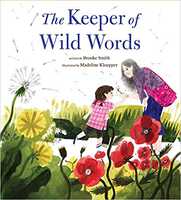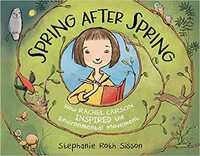Literary
The Keeper of the Wild Words

This charming picture book tells the story of a grandmother and granddaughter seeking out particular nature words that are disappearing. The sharing of "wild" knowledge, before it becomes "lost" and the sensory details provided by the text and beautiful illustrations are a powerful combination and will encourage nature observation and enjoyment.
Educator notes:
Informational
Spring After Spring: How Rachel Carson Inspired the Environmental Movement

This picture book biography chronicles the life of the famous environmentalist, Rachel Carson. Brimming with information, both visually and with text, this book will inspire young readers to observe the natural world around them, and will educate them about the difference one person can make when using the power of those observations.
Educator notes:
Topic: environment, nature, words
Age: Primary (K-3)
Active Learning Strategy: Vocabulary Building
Type: Individual and Whole Group Exercise Title: Capturing Lost Words!
Learning Objectives: The student will:
Description:
This activity involves students identifying unfamiliar words and listing them out to create a nature word worksheet. Students will build their word list individually and together as a group. This activity is meant to cover multiple subject areas and could continue synchronously throughout the school session. Students should be encouraged to add words regularly and time should be allowed for in depth discussion as time permits. Encourage sensory observations and have students engage with and ask any questions about the wonderful world of nature.
Materials:
Direct Instruction:
Guided and Independent Practice:
Topics on nature are endless and the words surrounding the various areas such as botany, biology, and meteorology, to name a few can build and strengthen vocabulary and comprehension. This limitless variety can spark the curiosity of students who may choose further observation and exploration on environmental topics. Connecting to the local environment will deepen the knowledge building of the student's own, observable natural world.
Sharing/Reflection/Closing:
This activity is a great way to build skills in using context clues and other resources to identify the meanings of new words and grow their vocabularies. As part of a larger curriculum about nature and eco literacy, this activity is a wonderfully engaging introduction to using the senses in our everyday life to explore, observe and learn. Picture book biographies are an engaging way to connect young students with real people who made a difference in the world. The theme of social change is also present and timely in these texts, and can supplement learning in other areas of the curriculum.
|
